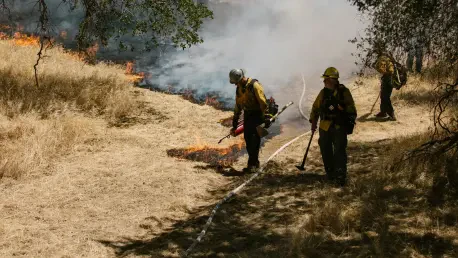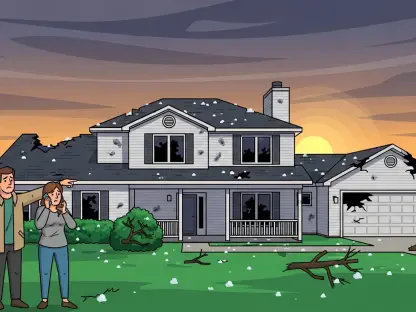California’s homeowners insurance market is experiencing a tumultuous upheaval driven by increasingly frequent and severe wildfires. As the state grapples with escalating climate risks, the interplay between these environmental threats and rising insurance costs presents formidable challenges. Recent fires, such as the notorious Palisades and Eaton disasters, have underscored the vulnerability of homes in fire-prone areas, leading to unprecedented infrastructure damage and financial burdens. Moreover, with the pandemic’s overshadowing influence waning, these issues have emerged as critical factors that shape not only the state’s housing landscape but also the broader economic and policy frameworks affecting homeowners across the United States.
Impacts of Wildfires on the Insurance Market
The Toll of Recent Wildfires
The relentless wildfires in Los Angeles served as a devastating wake-up call, inflicting damage on nearly 11,300 homes and culminating in a staggering economic toll of $52.5 billion. These fires have exposed weaknesses in the interconnected domains of housing affordability and insurance coverage, raising the alarm about the state’s ability to protect residents amid growing climate threats. With housing prices already soaring above the national average, the fires illuminated the fraught dilemma homeowners face, trying to balance adequate insurance coverage against the backdrop of prohibitive costs. Furthermore, this disaster emphasized the prevalence of risk, reflecting a future where housing strategies must carefully address the intensification of climate-induced challenges.
As climate change accelerates both the frequency and severity of wildfires, the implications for housing and insurance markets have become profoundly serious. They highlight a cycle of amplified risks, where high temperatures, prolonged droughts, and volatile weather patterns aggravate wildfire occurrences. This reality forces homeowners and policymakers to confront an array of immediate and long-term consequences. In addition to direct property damage, wildfires introduce a host of indirect effects, such as reduced housing stock, displaced communities, and increased rents. The challenge extends to maintaining a delicate equilibrium between swift rebuilding efforts and ensuring future resilience through refined policies that reinforce sustainable practices in housing development and insurance offerings.
Surging Insurance Premiums
Recent wildfires have brought into sharp focus the instability of California’s private homeowners insurance market. With surging premiums and rising nonrenewal rates, the environment is increasingly hostile for policyholders, especially those living in vulnerable regions. A Federal Insurance Office report highlighted that between 2025 and 2029, average homeowners insurance premiums in climate disaster-prone areas rose significantly above inflation. This led to a substantial financial strain, further complicating the affordability crisis for residents in fire-affected zones, such as Altadena and Pacific Palisades. Nonrenewal rates outpaced state and national averages, causing widespread concern among homeowners there.
Interactive data visualizations capture the stark rise in costs affecting Californians, with Pacific Palisades residents witnessing a 33 percent premium increase above inflation in recent years. Similarly, Altadena homeowners endured a 26 percent hike during the same period. These elevated burden levels exacerbate housing affordability issues for those already struggling in high-risk areas. Consequently, many are forced to seek alternatives lost to the private market, increasingly turning to state-run programs to mitigate personal financial strain. However, reliance on such programs highlights broader implications regarding the fragility of the private insurance market and signifies the monumental task policymakers face in ensuring coverage accessibility.
Responses and Strategies for Risk Mitigation
Expanding Role of the FAIR Plan
Faced with dwindling private insurance options, many California homeowners relied on the Fair Access to Insurance Requirements (FAIR) Plan more heavily than ever before. This strategy reflects the state’s burgeoning challenge to provide coverage access amid the market’s shifting dynamics. Since 2025, the FAIR Plan expanded by nearly fourfold, boasting over half a million policies by March of the comparable year. This exponential growth underscores profound financial stress within the homeowners insurance market, where shrinking affordability demands alternative pathways to secure adequate protection for residencies in high-risk zones.
Before the outbreaks of notorious fires, locations like Pacific Palisades and Altadena witnessed a notable surge in FAIR Plan enrollments, recording double the growth of the statewide average. These trends exemplify the critical reliance on state-supported pathways amid insufficient affordable choices in the private sector. Following significant fire events that catalyzed around 5,000 claims and an estimated burden of $4 billion, the FAIR Plan initiated emergency assessments on member insurers, staving off potential insolvency. This measure has far-reaching ramifications, redistributing costs across private entities and policyholders alike, effectively softening financial impacts statewide while maintaining an equitable share of expenses associated with the destructive fires.
Balancing Development with Climate Resilience
California’s enduring challenge lies in harmonizing housing development needs with the imperative to elevate climate resilience. State government leaders have recognized the crisis, termed a “statewide insurance predicament,” as urgent, driving efforts to adopt policies tailored to sustain private insurers within the market. A 17 percent increase in premium rates approved for State Farm underscores such attempts, signaling efforts to mitigate affordability concerns despite inherent barriers to attaining sufficient coverage. However, as affordability wanes, insurance solutions must evolve toward innovative pathways that ensure properties remain secure amidst volatile conditions.
The trajectory for recovery post-fire has historically signaled reduced housing supply, inflated rental rates, and heightened anxieties surrounding the preservation of communities and tax bases. Striking a balance between immediate reconstruction and policy fortifications that foster proactive regulation is crucial. Local authorities have championed actions streamlining rebuilding processes, reflecting a proclivity toward temporary restoration over prolonged environmental reviews that underpin long-term adaptability. Mayor Karen Bass’s approach in the wake of the Los Angeles fires reflects this inclination, underscoring a dichotomy between expedient recovery and sustainable planning that ultimately must navigate the complexities arising from increased future risk exposure.
Planning for Adaptive Resilience
Risk Mitigation Measures
The path toward resilient housing and insurance landscapes hinges on embracing strategies that minimize physical risk exposure. Promoting risk reduction measures during reconstruction offers tangible benefits: enabling properties to qualify for favorable insurance terms while safeguarding future affordability against mounting climate threats. Innovations in materials and construction practices, including adopting fire-resistant technologies, have emerged as prudent solutions underscoring the paradigm shift from reactive to preventive policies. Targeted regulations that encourage mitigation activities bolster the potential for premium savings and forge progress toward future-proofed communities.
Regulatory bodies have championed incentives for insurance solutions that emphasize resilience integration. Such products spotlight transformative opportunities to weave adaptive strategies into housing development, promoting an insurability ethos grounded in proactive climate responsiveness. By reimagining policy parameters, stakeholders can foster dynamic infrastructures that bolster insurability, aligning economic sensibilities with climate-conscious frameworks. This impetus for embracing future-oriented strategies signifies a profound commitment to ensuring sustainable housing and insurance solutions that support broader financial stability amid escalating climate risks.
Collaborative Efforts for Long-Term Solutions
California’s homeowners insurance market is currently facing significant challenges due to the increasing frequency and severity of wildfires. The state’s struggle with escalating climate risks creates a complex interaction between these environmental threats and the rising cost of insurance. Recent fires, such as the infamous Palisades and Eaton blazes, have highlighted the vulnerability of homes situated in fire-prone regions, resulting in substantial infrastructure damage and economic strain on homeowners. As the overshadowing effects of the pandemic recede, these issues have emerged as crucial factors that not only shape California’s residential landscape but also influence economic and policy frameworks nationally for homeowners. The intertwining of climate change with insurance creates formidable challenges that demand adaptive strategies from both policymakers and the insurance industry, affecting how homeowners perceive risk management and economic stability across the United States.









